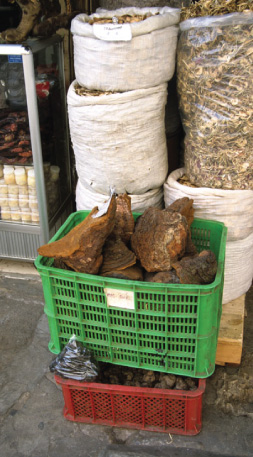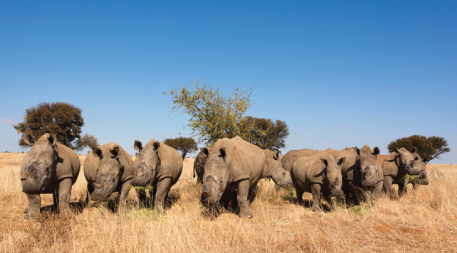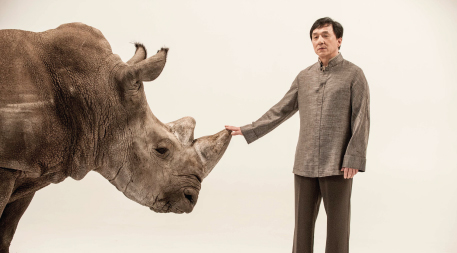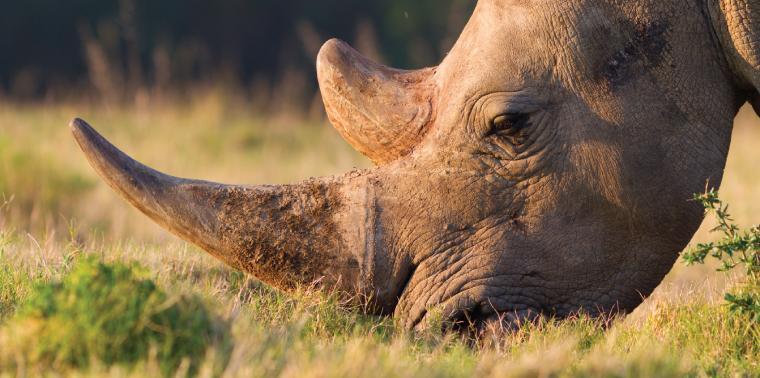August 7, 2013 — As home to more than 80 percent of Africa’s rhinos, South Africa has attracted the intense and unwelcome attention of poachers, who, through their illegal hunts, send the animal’s horns into a soaring international black market that supplies users concentrated in China and Vietnam.
Rhino horn has played a minor role in traditional Chinese medicine for centuries, mainly as a fever reducer. Today, although all rhino species are red-listed and international trade in rhino horn is banned, rhino horn is still consumed in China. In recent years it’s become fashionable among rich Vietnamese urbanites as well, who employ it as a hangover cure, a nonpsychoactive club drug or merely as a sign of wealth, according to journalists and illegal wildlife trade researchers.
This increased demand has driven retail prices over the $50,000 per kilogram mark, say conservationists. An adult southern white rhino can easily carry five kilograms of horn, a cool quarter million dollars’ worth of hard keratin growing on its face. That astronomical value is spurring on an increasingly sophisticated, cash-flush smuggling network that recruits African “triggermen” to kill rhinos across the country.
Between 1990 and 2007, South Africa lost 13 or so rhinos to poaching each year. In 2008 it lost 83, and every year since has seen a massive increase. An unprecedented 668 were poached in 2012.

Rhino horns fetch premium prices in Asian markets for traditional medicine and other uses, spurring deadly illegal trade. Photo © Maurice Joseph / Alamy.
Rhino poaching carries serious penalties in South Africa, and millions have been spent to protect the animals. Companies of soldiers with aerial support have even been placed in the Kruger National Park, a poaching hot spot. Triggermen often die in shootouts with authorities, but the payoffs are so great they keep coming. This year’s South African rhino poaching tally has just passed 550.
South Africa and the world are under pressure to do more, fast, to save these iconic beasts. Most conservationists advocate even stronger — and very expensive — law-enforcement measures. However, vocal rhino owners and influential wildlife economists have recently been joined by high-ranking South African government figures in calling for the current rhino conservation paradigm to be radically reconstructed. Instead of fighting the horn trade, they say, rhino custodians should join it.
A Better Idea?
The best way to support rhino conservation, the pro-traders argue, is for the horn trade to be legalized so African rhino custodians, private and public, can finance the animals’ continued protection and conservation. A legal trade may even reduce the demand for illegal horn and would bring transparency to the market, making it easier to study and control. Regularly and reliably supplying legal horn to Asian buyers, proponents say, would disincentivize speculators who can drive rapid, unpredictable surges in poaching.
Rhino horn can be painlessly harvested by tranquilizing an animal and carefully sawing off the horn above the delicate base of tissue from which it grows. The process takes about 20 minutes and the horn regrows at about 0.8 kilograms per year, allowing multiple harvests in a rhino’s lifetime. If horn trade were legal, custodians could sustainably harvest and sell horns from living animals, naturally deceased rhinos and horn stockpiles, earning money to underwrite conservation, pro-traders say.
On July 3 of this year South Africa’s minister of environmental affairs, Edna Molewa, told the media that “South Africa cannot continue to be held hostage by the syndicates slaughtering our rhinos. We do have the ability to make this scarce resource available without impacting on the species, through the implementation of a regulated trade system.” Her government will seek to legalize the rhino horn trade at the next top-level meeting of the parties to the Convention on International Trade in Endangered Species in 2016, she said.
Some private game ranchers are already intensively breeding rhino and harvesting their horns in anticipation of legal sales.An official in Molewa’s department said the government has accumulated a horn stockpile of 16,437 kilograms — more than 16 metric tons — that could benefit conservation, having a potential value of hundreds of millions of dollars.
Some private game ranchers are already intensively breeding rhino and harvesting their horns in anticipation of legal sales. John Hume, a well-known industry figure, now has more than 900 southern white rhinos on his property and more than two tons of stored horn. “The best way to ensure the rhino’s future is to make live rhino as economically valuable as possible,” he says.
Market Models
The South African government has yet to determine the structure for the market it seeks to establish, but economists and private rhino owners have proposed at least two possible models.
One model, laid out in most detail by economist Michael ’t Sas-Rolfes, would involve selling certified, marked, whole horns at open auction and promoting them to Asian consumers over illegal horns. ’t Sas-Rolfes’ primary intention is not to maximize profits to horn producers, but to give producers a fair return while keeping prices as low as possible to put a damper on illegal trade.
Another model, articulated by Michael Eustace, an investment analyst, envisages a central selling organization for rhino horn similar to that developed by diamond company De Beers. De Beers holds a large diamond stockpile from which it carefully releases different sizes and grades of stones at fixed prices to maximize profit, occasionally selling large volumes cheaply to destabilize competitors. Because a CSO is essentially a monopoly, it would have to be operated by governments, which are exempt from anti-monopoly laws.

Horns can be harvested from live rhinos with no permanent harm, producing a valuable resource that some propose could provide funds to support conservation if trade were legalized. Photo © Ann and Steve Toon / Alamy.
Eustace sees a rhino CSO holding regular sales of certified horn at a central location to preapproved buyers at a price determined by market analysts. The CSO would seek to maximize the price in order to achieve high profits for rhino custodians and to constrain demand; Eustace says the high price of rhino horn limits the pool of customers because relatively few people are rich enough buy it. “I don’t think you can afford to lower the price, because you can’t satisfy demand [i.e., produce enough legal horn for a larger pool of buyers] at a lower price,” he says.
Both models would require governments on both the production and the consumption end of things to strengthen enforcement efforts against illegal trade to raise the criminals’ cost of doing business. And both assume significant investment in rhino protection, which would be funded by proceeds from the trade, to be necessary for the indefinite future. (There are early indications that the South African government favors a CSO-type model, perhaps housed within the Johannesburg Stock Exchange.)
Unconvinced
Some conservation groups are skeptical. Jo Shaw, WWF-South Africa’s rhino expert, says that the group
“remains unconvinced that the legal international trade in rhino horn is a feasible approachMany others are outright hostile to legal trade, saying there are too many uncertainties involved. for rhino conservation at this time.” The U.S. Fish and Wildlife Service, which has supported conservation in Africa for decades, is staying out of the debate, simply noting that it “will evaluate any proposal submitted according to the public process we’ve established for CITES proposals.”
Many others are outright hostile to legal trade, saying there are too many uncertainties involved. “If you put it on the market, you’re saying it’s OK,” says Allison Thomson, a South African rhino conservation advocate. Making rhino horn socially acceptable is extremely risky because it might stimulate massive new demand that legal traders could never satisfy, she says.
A legal trade would also provide cover for the illegal trade, says Mary Rice of the Environmental Investigation Agency, a London-based organization that has investigated the illegal wildlife business for decades. One needs to look no further than the elephant ivory trade to see how this happens, she says.
The international trade in elephant ivory was banned in 1989, but CITES has allowed two one-off sales of ivory stockpiles since then. The sales, which were agreed upon in 1997 and 2008, allowed southern African countries with CITES-approved elephant management policies to auction their stockpiles — the product of culling operations and natural deaths — to Asian countries with CITES-approved regulation systems. The sales were intended to reward countries that managed elephants well and, by flooding Asian markets, depress the price of illegal ivory.
Writer Bryan Christy, who recently investigated the ivory business for National Geographic, says that a 2002 Chinese report to CITES attributed a surge in ivory smuggling to the 1997 Japan sale. Consumer demand rose in the wake of the legal sales, boosting the black market ivory business. He also says Chinese and Japanese dealers colluded to game the 2008 auctions in order to lower prices, shortchanging the selling countries.
“A legal market … makes it virtually impossible for enforcement people to determine what is and isn’t legal. It makes their job very, very difficult.” — Mary RiceTo top it all, China pooled its legally bought ivory within a version of a central selling organization from which it sells limited quantities at above-black-market prices to Chinese ivory carvers, thus keeping the retail price high and maintaining the incentive to poach. A recent EIA investigation found that as much as 90 percent of the ivory in the Chinese market came from illegal sources, and data show that elephant poaching has increased dramatically across Africa since 2009.
“A legal market provides a laundering mechanism for illegal ivory,” says Rice. “It makes it virtually impossible for enforcement people to determine what is and isn’t legal. It makes their job very, very difficult.”
But ’t Sas-Rolfes argues that the CITES-sanctioned ivory auctions should not be used to predict the outcomes of a regulated, sustained market for rhino horn. One-off sales are a bad idea because they provide no predictability to the market, he says. And, unlike rhino horn, elephant ivory sales are inherently problematic because ivory can’t practically be harvested from a living elephant, and natural deaths are too few to satisfy Asian demand for “white gold.”
Altering Attitudes
Taking another tack, a small group of activists suggests the trade debate is moot. They argue that Asian consumers can be persuaded not to buy rhino horn in much the same way they’ve been encouraged to turn against shark fin, which is used in expensive soup by Chinese communities worldwide.
If a campaign to reduce demand for rhino horn is as successful as the shark fin campaign, it might be a crucial part of the struggle to save Africa’s rhinos.The California-based group WildAid started researching the shark fin trade in Hong Kong, Singapore and Taiwan in 1998, then put together high-profile, celebrity-endorsed campaigns against it. By 2002, says WildAid executive director Peter Knights, shark fin use was falling in these territories, and consumption had shifted to an increasingly wealthy mainland China.
WildAid refocused its efforts there. In the run-up to the 2008 Beijing Summer Olympics, it launched a new campaign that emphasized the cruelty of finning and included appearances by basketball superstar Yao Ming.
Numerous conservation and animal welfare groups now campaign against shark fin both inside China and around the world. They’ve pushed hotel chains and airlines to quit serving and transporting shark fin. Last year the Chinese government announced a ban on shark fin soup at official banquets. Hong Kong, the hub of much of China’s shark fin distribution, announced that imports dropped 70 percent from 2011 to 2012.
“The cruelty message really reached people,” says Iris Ho, wildlife campaigns manager of Humane Society International, which is involved in the campaign against shark fin use. “But when it was followed by a conservation message, that magnified the impact.” Ho says that catching the attention of consumers with dramatic media and then giving them more detailed information face to face had a lasting effect.
Knights is strongly against legalizing the rhino horn trade because he fears putting legal horn on the market
might promote it to a user base far larger than a legal trade could supply, further intensifying poaching pressure. “We can’t have more than a million consumers of rhino horn currently,” he says, “but if you legalize it you could have a hundred million in China alone.” It could also confuse consumers who have seen messages that strongly discourage rhino horn use, damaging the prospects of demand-reduction efforts such as WildAid’s.

International film star Jackie Chan and Spike, a rhino orphaned by poachers, star in a soon-to-be-released WildAid public service announcement aimed at deterring consumers in China and Vietnam from buying products made from rhino horn. Photo by Vern Evans Photography for WildAid.
Media campaigns are cheap compared to on-the-ground anti-poaching actions, says Knights. His group has made anti-rhino-horn videos featuring Asian megastars such as Jackie Chan and Li Bingbing, which they plan to roll out across the region. China is not a monolithic entity, he says, but a place where “everything’s changing, so it’s a great time to have societal attitudinal change. You’re not fighting the wave, you’re going with it.”
Many conservationists downplay demand-reduction campaigns, claiming they do not change things fast enough and are too uncertain to stem the current poaching crisis. But, if a campaign to reduce demand for rhino horn is as successful as the shark fin campaign, it might be a crucial part of the struggle to save Africa’s rhinos.
Whatever’s being done now to conserve rhinos is clearly not working. At the current rate, South Africa will lose between 900 and 1,000 rhinos to poaching this year — and if trends hold, poaching losses will outstrip new rhino births by 2016. It will take cool heads and a willingness to put aside many assumptions in order to craft a successful rescue strategy. ![]()
UPDATED 08.08.13: The paragraph on Bryan Christy’s comments on the 1997 sale of ivory and the subsequent surge in smuggling was updated.
Ensia shares solutions-focused stories free of charge through our online magazine and partner media. That means audiences around the world have ready access to stories that can — and do — help them shape a better future. If you value our work, please show your support today.
Yes, I'll support Ensia!
